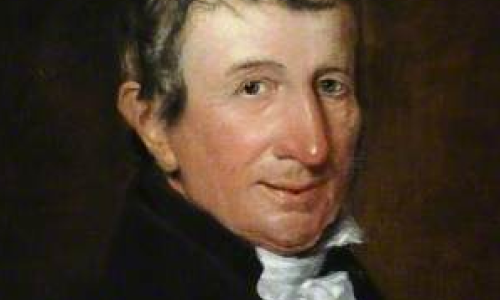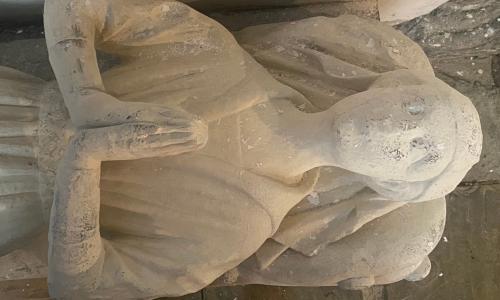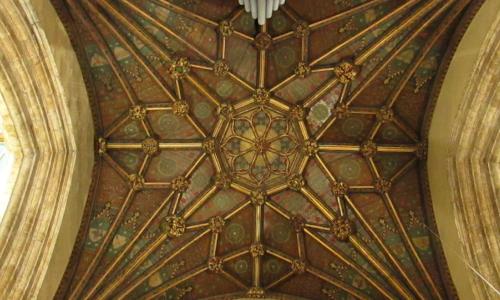Who was William?
William Westerdale was born in 1770, one of six children born to George (1732-95) and Sarah Westerdale (nee Cook, 1733-98). George was a cabinet maker living on High Street, Hull according to The First Hull Directory (Appendix,1792). On 17 September 1798 William married Essex (also known as Esther) Dove (1768-1846) at Sculcoates and they had seven children. Not much was known about him until we excavated his grave during the Trinity Square public realm works. His was the only burial to be identified during the landscaping because his coffin plate was well preserved and clear.
Our team of volunteers researched his life and found the story of a man who contributed immensely to the growth of shipping and commerce in Hull.
William Westerdale was born in 1770 at a time of huge growth and development in Hull. He was baptised at Holy Trinity Church on the 15th November, the same day as John Healey Bromby who would go on to be Britain's longest serving vicar. When Westerdale dies 66 years later, it is Bromby who records his death in the parish registers.
The map below shows Hull at the time of Westerdale's early life. By 1791 he is 21 years old. A block and mast works has already been established on the southern tip of Hull on the Humber.
By 1803 William is recorded as a Blockmaker on North Dockside, Hull and living in Saville Street. At the mouth of the Humber and on the dockside, Westerdale's business was well placed to carry out repairs and maintenance to ships passing in and out of the port of Hull.
By 1817 he is listed as a block, mast and tackle maker. Baines Directory of 1823 list William Westerdale as a Mast, Block and Pump Maker at 1 Pier Street and Old Dockside. The 1834 Poll Book for Hull also records him at Pier Street and shows him as the owner of six freehold properties. Pigot’s Directory of the same year lists Westerdale as a marine strs (sic), and also under Mast, Car (sic), Block & Pump Makers at the south end of Humber Dock and the west end of the Old Dock.
The products made by mast, block and tackle manufacturers were very important to shipping so Westerdale’s products were crucial parts of both shipbuilding and ship maintenance. Each ship needed several masts and spares preferably made from the trunk of one tree but sometimes laminated. Blocks and tackle were a type of pulley used for running ropes through and hoisting up enormous sails, so dozens were needed on every ship, with plenty of spares in case of breakage. Pumps were also essential to remove water from inside the ship.
Paintings of Westerdale's Yard
Three paintings associated with Westerdale exist, all by Robert Willoughby (one of Hull’s most accomplished artists). In 1810 Willoughby painted a picture of Westerdale’s Yard. This shows workmen hauling what is possibly a mast across the yard. The yard had been built on reclaimed land with a staithe on the bank of the Humber before the Humber Dock was built. The map at the top of this article shows a ship in water next to the shipyard.
The second is a painting of his imposing house at 1 Pier Street which was built on reclaimed land soon after the opening of Humber Dock in 1809.
A third painting by Willoughby is called Westerdale’s Yard and the 'Wellington' from the New Dock, circa 1820. This image show people at leisure in fine clothing boarding a sailing ship. Behind them, St John's church tower - now the site of Feren's Art Gallery can be seen.
These paintings give us an intriguing sight into Westerdale’s life and the area in which he lived, and the expansion of his business. There may be other paintings relevant to Westerdale as he seems to have been one of Willoughby’s patrons. Westerdale’s house is shown as a three-storeyed red brick building with four bays to the front and stands in glorious isolation overlooking the Humber. It seems to have had at least eighteen chimneys.
William's Funeral Furnishings
William died in 1837, aged 66, leaving around £4,000 (345,000 today), and was buried at Holy Trinity Church; his address was recorded as Wellington Street. His exhumed skeleton revealed several interesting features about William: as a child he had suffered from rickets (not uncommon in those days). Despite this he grew to be a tall man but had the wrong number of bones in some parts of his spine and some bones were fused together (spondylitis). This seems to indicate that he undertook hard physical labour during his life.
It is possible that his coffin and the fittings for it were made in his own yard by his employees. They are cut from strong industrial metal in straight lines and etched with his name and date of death. His daughter was buried next to him. Their remains are now in the crypt of Hull Minster.
All paintings are reproduced with kind permission of the Feren's Art Gallery, Hull.




